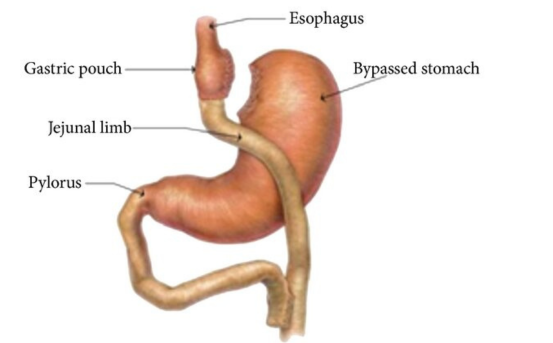Roux-en-Y Gastric Bypass (RYGB) has long been regarded as the “gold standard” in bariatric surgery. First developed in the 1960s and refined over decades, RYGB remains one of the most widely performed and trusted weight loss procedures across the globe. It combines both restrictive and malabsorptive mechanisms limiting how much food the stomach can hold while also reducing the absorption of calories and nutrients by rerouting part of the small intestine. This dual-action approach often leads to substantial and sustained weight loss, improved metabolic function, and, in many cases, complete resolution of obesity-related illnesses.
Bariatric surgery has transformed the lives of millions suffering from obesity and its associated comorbidities. Among various surgical options, Roux-en-Y Gastric Bypass (RYGB) stands out as one of the most effective and commonly performed procedures worldwide. While many recognize RYGB as a singular surgical technique, there are actually different types and technical variations of Roux-en-Y Gastric Bypass surgery tailored to patient needs and surgeon preferences.
What is Roux-en-Y Gastric Bypass?
Roux-en-Y Gastric Bypass is a combination of restrictive and malabsorptive bariatric surgery. It reduces stomach size and reroutes part of the small intestine to limit food intake and nutrient absorption. The result is significant and sustained weight loss, alongside improvements or resolution of conditions like type 2 diabetes, hypertension, sleep apnea, and GERD.
The procedure gets its name from the “Y”-shaped configuration created by the re-routing of the small intestine.
Key Features of Standard RYGB :-
-
Stomach is divided into a small upper pouch (~30 ml) and a larger excluded remnant.
-
The small intestine is divided and rearranged to form the “Roux limb,” where food bypasses the duodenum and part of the jejunum.
-
Digestive enzymes mix with food farther down the intestinal tract.
Why Are There Different Types of Roux-en-Y Gastric Bypass?
Though the core concept remains the same, surgeons may alter certain technical aspects to suit the patient’s weight, comorbidities, or previous surgical history. These changes create variants of the standard RYGB, each with subtle differences in limb lengths, pouch sizes, or surgical approaches.
Understanding these variations helps patients make informed decisions and allows surgeons to tailor the procedure to maximize safety and results.
Types of Roux-en-Y Gastric Bypass Surgery
Standard Roux-en-Y Gastric Bypass (Traditional RYGB)
Overview :- This is the classic approach most commonly performed worldwide.
Key Characteristics :-
-
Gastric pouch: 15–30 ml.
-
Alimentary (Roux) limb: ~100–150 cm.
-
Biliopancreatic limb: ~30–50 cm.
Benefits :-
-
Balanced restriction and malabsorption.
-
High success rate for weight loss and metabolic improvement.
-
Good for BMI 35–50 patients.
Considerations :-
-
Risk of vitamin and mineral deficiencies.
-
Potential for dumping syndrome.
Long-Limb Roux-en-Y Gastric Bypass
Overview :- This version uses a longer Roux limb (150–200 cm or more) to enhance malabsorption.
Ideal for :- Super-obese patients (BMI > 50) or those with severe metabolic disease like uncontrolled type 2 diabetes.
Key Characteristics :-
-
Alimentary limb: >150 cm.
-
Greater segment of the small intestine bypassed.
Benefits :-
-
Enhanced weight loss due to increased malabsorption.
-
Better glycemic control in diabetes.
Risks :-
-
Higher chance of nutritional deficiencies.
-
More stringent supplementation required.
Distal Roux-en-Y Gastric Bypass
Overview :- The Roux limb is placed more distally (closer to the colon), creating a shorter common channel.
Ideal for :- Patients requiring maximum malabsorption due to inadequate weight loss from previous surgeries.
Key Characteristics :-
-
Very long Roux limb (200–250 cm).
-
Short common channel for nutrient absorption.
Benefits :-
-
Superior weight loss and metabolic impact.
-
Useful in revision surgeries.
Risks :-
-
High risk of protein-calorie malnutrition.
-
Steatorrhea (fatty stools), diarrhea, and deficiencies in fat-soluble vitamins.
Proximal Roux-en-Y Gastric Bypass
Overview :- This is essentially the same as the standard RYGB and is considered the safest variation for most patients.
Key Characteristics :-
-
Roux limb attached more proximally (closer to the start of the jejunum).
-
Balanced restriction and malabsorption.
Benefits :-
-
Lower risk of nutritional complications.
-
Effective for moderate obesity and metabolic syndrome.
Mini Gastric Bypass (MGB) or One Anastomosis Gastric Bypass (OAGB)
Note :- While not a “Roux-en-Y” per se, this is often compared or mistaken as a variant due to similar mechanisms.
Key Characteristics :-
-
Single anastomosis (loop) instead of Y-configuration.
-
Longer biliopancreatic limb.
Benefits :-
-
Shorter operative time.
-
Excellent weight loss and diabetes remission.
Risks :-
-
Risk of bile reflux.
-
Controversial in some regions due to long-term outcomes.
Choosing the Right Type of RYGB for You
Every bariatric surgery candidate is unique. Factors that influence the type of Roux-en-Y Gastric Bypass chosen include :-
-
Body Mass Index (BMI)
-
Severity of comorbid conditions
-
Previous abdominal surgeries
-
Patient compliance with follow-ups
-
Surgeon’s expertise and experience
A thorough pre-operative evaluation by a bariatric surgeon, dietitian, and endocrinologist ensures the optimal approach is selected.
Benefits of Roux-en-Y Gastric Bypass (All Types)
Regardless of the variation, RYGB surgery offers numerous benefits :-
-
60–80% excess weight loss in the first 1–2 years.
-
High rates of diabetes remission.
-
Reduction in cardiovascular risk.
-
Improved mobility, fertility, and quality of life.
-
Resolution of obstructive sleep apnea, GERD, and hypertension.
Potential Risks and Complications
All types of RYGB share certain risks :-
-
Dumping syndrome (especially with sugary foods).
-
Vitamin and mineral deficiencies (iron, B12, calcium, D).
-
Internal hernias or strictures.
-
Ulcers or marginal ulceration at anastomosis.
-
Need for lifelong dietary changes and supplementation.
Proper follow-up and adherence to dietary guidelines are key to minimizing complications.
Conclusion
Roux-en-Y Gastric Bypass is a powerful tool in the fight against obesity and metabolic disease. Understanding the different types of RYGB surgery allows for personalized treatment, maximizing weight loss while minimizing risks. Whether you’re undergoing standard, long-limb, or distal RYGB, success largely depends on compliance, lifestyle changes, and medical follow-up.























